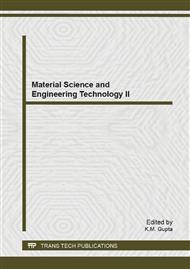p.123
p.128
p.137
p.142
p.147
p.153
p.159
p.164
p.169
Validation of Nitinol SMA Characteristics Using Finite Element Analysis and Closed Form Solutions
Abstract:
Shape Memory Alloys (SMA) are promising materials for actuation in space applications, because of the relatively large deformations and forces that they offer. However, their complex behaviour and interaction of several physical domains (electrical, thermal and mechanical), the study of SMA behaviour is a challenging field. Present work aims at correlating the Finite Element (FE) analysis of SMA with closed form solutions and experimental data. Though sufficient literature is available on closed form solution of SMA, not much detail is available on the Finite element Analysis. In the present work an attempt is made for characterization of SMA through solving the governing equations by established closed form solution, and finally correlating FE results with these data. Extensive experiments were conducted on 0.3mm diameter NiTinol SMA wire at various temperatures and stress conditions and these results were compared with FE analysis conducted using MSC.Marc. A comparison of results from finite element analysis with the experimental data exhibits fairly good agreement.
Info:
Periodical:
Pages:
147-152
Citation:
Online since:
December 2013
Authors:
Keywords:
Price:
Сopyright:
© 2014 Trans Tech Publications Ltd. All Rights Reserved
Share:
Citation:


